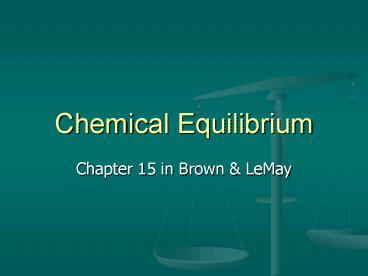Chemical Equilibrium - PowerPoint PPT Presentation
1 / 12
Title:
Chemical Equilibrium
Description:
A(g) B(g) A(g) B(g) rate = kf[A] A(g) B(g) rate = kr[B] ... R and T are constant. Kf/kr = PB/PA. This is called the equilibrium constant. The constant ... – PowerPoint PPT presentation
Number of Views:16
Avg rating:3.0/5.0
Title: Chemical Equilibrium
1
Chemical Equilibrium
- Chapter 15 in Brown LeMay
2
Definition
- Occurs when opposing reactions are occurring at
the same time - Weve had physical equilibria before
- dissolving
- vapor pressure
- We will use partial pressure for gases
- We will use molarity for solutes
3
Why partial pressure?
- A(g) ? B(g)
- A(g) ? B(g) rate kfA
- A(g) ? B(g) rate krB
- For ideal gas equation, what is the concentration
of the gas? - n/v P/RT
4
At Equilibrium
- Rate of forward rate of reverse
- kfPA/RT krPB/RT
- R and T are constant
- Kf/kr PB/PA
- This is called the equilibrium constant
5
The constant
- Use this as an example
- N2(g) 3H2(g) ? 2NH3(g)
- This is called the Haber Process. Why?
- Equilibrium conditions can be reached from either
direction - Equilibrium expression uses coefficients as
exponents, products over reactants - Do it for above reaction
6
Good Website
- http//jersey.uoregon.edu/vlab/Thermodynamics/
7
Constant cont
- It is the value specific for that reaction under
those conditions, no matter what you start with - animation
- Keq greater than 1 products favored
- Keq less than 1 reactants favored
- Temperature dependent defined for one
temperature - Keq for a reaction is 1/Keq for the reverse
- If reaction is multiplied by 2, Keq is squared,
etc. - Dimensionless
- Try some problems
8
Heterogeneous Equilibria
- Not just gases or solutions
- Solids, liquids included in reaction
- CaCO3(s) ? CaO (s) CO2(g)
- Pure solids, liquids, and solvents are not
included in the equilibrium expression because
their concentration is usually in excess and does
not change significantly in the reaction.
9
Calculating Keq
- Easy when all concentrations are known just
substitute - Try PE
10
RICE Problems
- RICE is a table approach to solving equilibria
problems - Reaction, Initial conc,Change in conc,
Equilibrium conc - Used when there are unknowns in a problem
- Try one together bottom of page 589
- PE
11
Q Problems
- Used when concentrations of reactants and
products are given (or calculated by RICE) and
Keq is given - Question asked is Has equilibrium been reached?
- Called Q or reaction quotient
- Calculated using Keq expression
- If Q lt Keq, reaction must go to right
- If Q gt Keq, reaction must go to left
12
X problems
- Used when amounts of reactants or products at
equilibrium are unknown - You may or may not need to use RICE
- Use x for unknown amounts
- We will not have to use the quadratic equation
- Try PE































